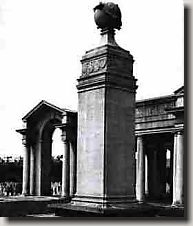A Memorial to the Airmen of the Great War
Part of the Arras Memorial in the Faubourg d'Amiens Cemetery is generally regarded as a tribute to those who lost their lives in the early battles in the air. Just inside the cemetery is the Airmen's Monument, a tall plinth surmounted by a globe. On its sides are inscribed the names of all the airmen who perished on the Western Front and have no known resting place. Included are the names of 46 Canadians.
The War in the Air
The airplane, regarded by military authorities in 1914 as little more than a novelty, became, over the next four years, a military necessity. Remarkable technical advances in aerial warfare enabled the aircraft to fulfil ever-expanding functions. In the early stages of the war aircraft were used largely for reconnaissance, to observe enemy troop movements and spot artillery, and to obtain photographs and motion pictures. Then came the bombers and fighters as airmen sought to destroy railroad centres and industrial targets far behind enemy lines, to destroy Zeppelin bases, and to hunt submarines at sea.
The war in the air offered to the airman and to the public a glimpse of the fame and glory once expected of war, at a time when mud and shells turned battlefields into nightmares of horror and revulsion. The flyer became a new kind of warrior- a chivalric, twentieth century, knight-errant. Men went up in rickety planes with few instruments and no parachutes. The fighter pilot was one of the elite, one of the most daring, and his job was one of the most dangerous. What started out as a hazardous adventure developed into a science. One third of all the fliers died in combat, among them 1,600 Canadians.
Canadian airmen played a particularly significant and brilliant role in the air. No fewer than 25,000 Canadians served with the British air service as pilots, observers and mechanics, in every theatre of the war. Canadian airmen won more than 800 decorations and awards for valour, including three Victoria Crosses. The names of such Canadian flyers as W.A "Billy" Bishop, W.G. Barker, Raymond Collishaw and A.A. McLeod became household names in Canada, and they left a record of daring and devotion that was famous everywhere.
Directions
Faubourg-d'Amiens Cemetery is in the western part of the town of Arras in the Boulevard du General de Gaulle, near the Citadel, approximately 2 kilometres due west of the railway station. Part of the Arras Memorial in the Faubourg-d'Amiens Cemetery is generally regarded as a tribute to those who lost their lives in the early battles in the air. Just inside the cemetery is the Airmen's Monument.
- Date modified:
